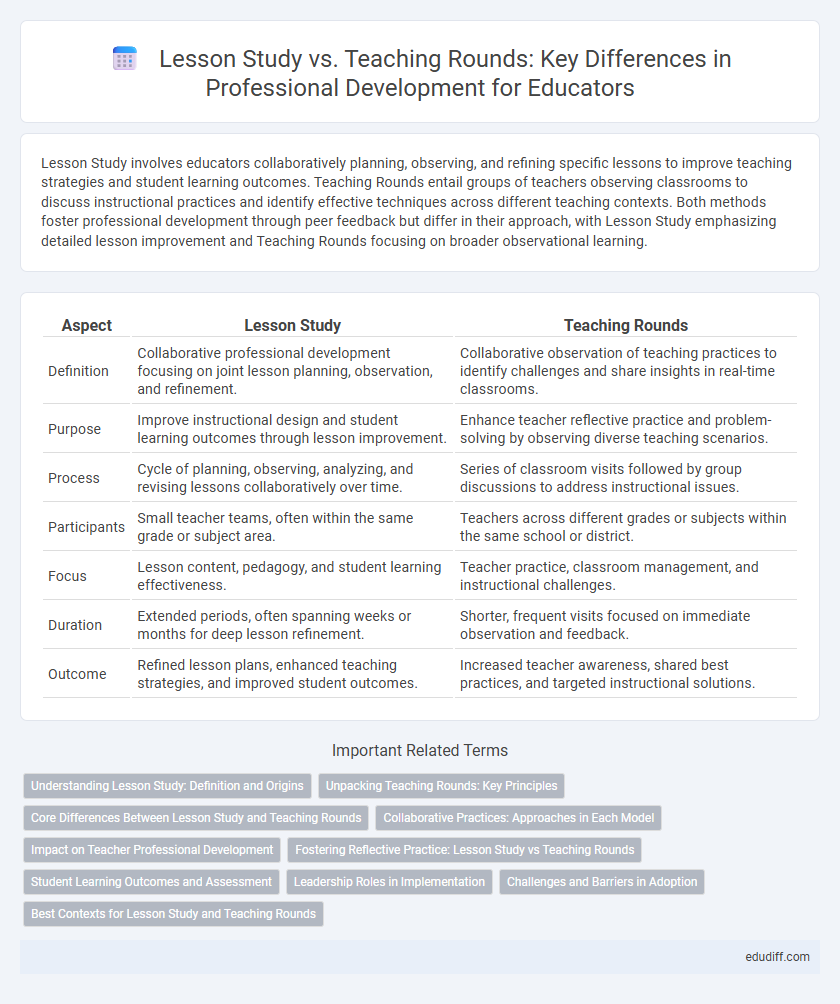Lesson Study involves educators collaboratively planning, observing, and refining specific lessons to improve teaching strategies and student learning outcomes. Teaching Rounds entail groups of teachers observing classrooms to discuss instructional practices and identify effective techniques across different teaching contexts. Both methods foster professional development through peer feedback but differ in their approach, with Lesson Study emphasizing detailed lesson improvement and Teaching Rounds focusing on broader observational learning.
Table of Comparison
| Aspect | Lesson Study | Teaching Rounds |
|---|---|---|
| Definition | Collaborative professional development focusing on joint lesson planning, observation, and refinement. | Collaborative observation of teaching practices to identify challenges and share insights in real-time classrooms. |
| Purpose | Improve instructional design and student learning outcomes through lesson improvement. | Enhance teacher reflective practice and problem-solving by observing diverse teaching scenarios. |
| Process | Cycle of planning, observing, analyzing, and revising lessons collaboratively over time. | Series of classroom visits followed by group discussions to address instructional issues. |
| Participants | Small teacher teams, often within the same grade or subject area. | Teachers across different grades or subjects within the same school or district. |
| Focus | Lesson content, pedagogy, and student learning effectiveness. | Teacher practice, classroom management, and instructional challenges. |
| Duration | Extended periods, often spanning weeks or months for deep lesson refinement. | Shorter, frequent visits focused on immediate observation and feedback. |
| Outcome | Refined lesson plans, enhanced teaching strategies, and improved student outcomes. | Increased teacher awareness, shared best practices, and targeted instructional solutions. |
Understanding Lesson Study: Definition and Origins
Lesson Study, a collaborative professional development process originating in Japan, involves teachers systematically examining and improving their instructional practices through joint planning, observation, and reflection on actual classroom lessons. Unlike Teaching Rounds, which emphasize peer observation and feedback in diverse settings, Lesson Study centers on iterative lesson refinement and deepening content knowledge within a consistent teacher group. This method fosters continuous instructional improvement grounded in shared inquiry and student learning outcomes.
Unpacking Teaching Rounds: Key Principles
Teaching Rounds emphasize collaborative observation and reflection within professional learning communities, focusing on improving instructional practice through shared insights and evidence-based discussions. Key principles include systematic observation, collective analysis of teaching challenges, and cyclical feedback to refine pedagogical strategies. This process fosters a culture of continuous improvement by engaging educators in joint problem-solving and instructional innovation.
Core Differences Between Lesson Study and Teaching Rounds
Lesson Study involves collaborative planning, observation, and analysis of a single lesson to improve teaching practices, while Teaching Rounds focus on observing multiple classrooms to identify broader instructional trends. Lesson Study emphasizes deep, reflective dialogue centered on one lesson's design and student learning, whereas Teaching Rounds prioritize collective inquiry through shared observations across different teachers. The core difference lies in Lesson Study's detailed examination of lesson implementation versus Teaching Rounds' systemic approach to professional development across various teaching contexts.
Collaborative Practices: Approaches in Each Model
Lesson Study emphasizes in-depth collaborative planning, observation, and reflection among educators to improve teaching practices and student learning outcomes. Teaching Rounds involve groups of teachers visiting each other's classrooms to observe real-time instruction and discuss strategies, fostering peer feedback and continuous professional development. Both models prioritize collective inquiry but differ in the structure and intensity of collaboration, with Lesson Study being more cyclical and research-oriented, while Teaching Rounds focus on observational learning and immediate dialogue.
Impact on Teacher Professional Development
Lesson Study fosters collaborative reflection and continuous improvement by engaging teachers in cyclic planning, observing, and analyzing lessons, which directly enhances instructional skills and pedagogical knowledge. Teaching Rounds promote peer observation and feedback within a clinical, evidence-based framework, leading to increased awareness of teaching practices and targeted professional growth. Both methodologies drive meaningful professional development but differ in structure and emphasis on collaborative inquiry versus observational learning.
Fostering Reflective Practice: Lesson Study vs Teaching Rounds
Lesson Study emphasizes collaborative reflection among teachers to design, observe, and refine lessons collectively, fostering deep professional dialogue and continuous improvement. Teaching Rounds provide structured peer observations followed by reflective discussions, promoting the sharing of best practices and evidence-based feedback. Both methods cultivate reflective practice by encouraging critical analysis of teaching strategies through systematic observation and collaboration.
Student Learning Outcomes and Assessment
Lesson Study promotes continuous improvement in student learning outcomes by collaboratively designing, observing, and refining lessons based on real-time classroom assessment data. Teaching Rounds focus on sharing best practices among educators through peer observation cycles, emphasizing qualitative assessment of instructional strategies and their impact on student engagement. Both methods enhance formative assessment practices, but Lesson Study provides a more structured framework for analyzing detailed student performance metrics to inform targeted pedagogical adjustments.
Leadership Roles in Implementation
Lesson Study emphasizes collaborative leadership where teachers actively lead the planning, observation, and reflection processes, fostering shared responsibility and professional growth. Teaching Rounds require formal leadership roles, often involving administrators or instructional coaches who coordinate observations and facilitate discussions to align practice with school-wide goals. Effective implementation depends on clear leadership structures that support continuous teacher learning and data-driven instructional improvements.
Challenges and Barriers in Adoption
Lesson Study faces challenges such as time-intensive collaboration and differing teacher expertise levels, which hinder consistent implementation in diverse educational settings. Teaching Rounds encounter barriers related to administrative support, scheduling conflicts, and resistance to peer observation, limiting widespread adoption. Both approaches require structured frameworks and cultural shifts to overcome reluctance and ensure sustainable integration into professional development.
Best Contexts for Lesson Study and Teaching Rounds
Lesson Study is best suited for collaborative professional development in schools aiming to improve instructional techniques through detailed lesson planning and iterative refinement. Teaching Rounds function effectively in contexts where educators observe peer teaching to identify best practices and address diverse learner needs in real-time classroom settings. Both approaches thrive in environments prioritizing continuous teacher learning and systemic improvement.
Lesson Study vs Teaching Rounds Infographic

 edudiff.com
edudiff.com